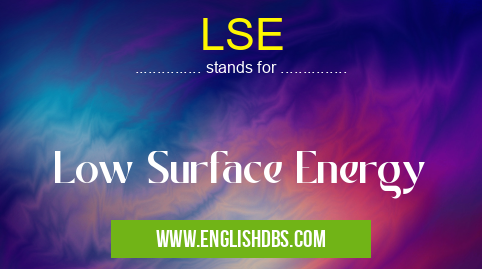What does LSE mean in CHEMISTRY
Low Surface Energy (LSE) is a term used in the engineering field to describe surfaces that have lower energy levels than other surfaces. These low energy surfaces are often advantageous for a variety of reasons such as increased adhesion, improved release, and decreased surface friction. The increased adhesion capabilities of LSE-treated surfaces make them ideal for use in industrial applications where high durability and performance are paramount.

LSE meaning in Chemistry in Academic & Science
LSE mostly used in an acronym Chemistry in Category Academic & Science that means Low Surface Energy
Shorthand: LSE,
Full Form: Low Surface Energy
For more information of "Low Surface Energy", see the section below.
Low Surface Energy
Low surface energy materials have molecules that interact with one another more weakly than do molecules on other surfaces. This interaction produces a lower surface energy that makes it difficult for particles, liquids, or objects on the surface to stick together. As a result, these materials have higher resistance to adhesive forces and are also less prone to corrosion due to air or water vapors. Furthermore, they tend to be more resistant to scratches and abrasion as compared with higher surface energy materials. Another property of low surface energy materials is their ability to repel dirt particles which can help keep products clean and attractive throughout its life cycle. Surfaces treated with LSE also offer enhanced slip resistance abilities which can prove beneficial in gripping products that are used in industrial settings such as manufacturing plants or warehouses. In addition, low surface energy materials are often seen as the top choice when it comes to many projects requiring painting since these coatings will tend not to peel off due to their lack of adhesion as well as their natural resistance against abrasion over time.
Essential Questions and Answers on Low Surface Energy in "SCIENCE»CHEMISTRY"
What is Low Surface Energy (LSE)?
Low Surface Energy (LSE) refers to a material's ability to resist wetting or adhesion. It is the measure of the difficulty for a liquid to spread across and stick to a surface. LSE materials are hydrophobic, meaning they repel water and other liquids instead of absorbing them.
What type of materials can have Low Surface Energy?
Materials such as polyethylene, polypropylene, polytetrafluoroethylene (PTFE), nitrile rubber, silicones and fluoropolymers are examples of materials that can have low surface energy.
How can Low Surface Energy be measured?
Low surface energy can be quantitatively measured by comparing contact angles formed between the test material and various liquids such as water, diiodomethane, n-hexadecane or ethylene glycol. If the contact angle is greater than 90 degrees then it is known to possess low surface energy.
What are the benefits of Low Surface Energy?
There are many benefits to having a low surface energy material including improved durability, scratch resistance, chemical resistance and easy cleaning and maintenance. These materials also offer protection against corrosion and staining due to their ability to limit the amount of liquids that will come in contact with surfaces.
How is Low Surface Energy used in industry?
In industry, low surface energy materials are often used to coat or protect surfaces from environmental contamination as they do not absorb moisture or dirt easily making them ideal for this purpose. They can also be used in medical devices as they repel bodily fluids which reduces infection risk while still allowing proper functionality.
Does having a high Surface Energy improve adhesion?
Yes! High surface energy materials typically provide better adhesion compared to low surface energy materials because they create strong bonds when applied correctly with an adhesive. High surface energy surfaces ensure more secure bond lines which helps increase product life cycle.
Is there any disadvantage associated with Low Surface Energy?
Yes! One major disadvantage associated with low surface energy is the potential for electrostatic discharge (ESD). ESD occurs when two objects with different electrical potentials come into contact generating an electric field which can cause physical damage along with safety hazards.
How does printing ink react on a material with Low Surface Energy?
Inks generally have trouble sticking on lower surface energies such as PTFE however some specialized formulations have been created specifically for use on LSE surfaces that provides good adhesion without significantly reducing its slickness or non-stick properties.
Final Words:
Low surface energy materials offer multiple advantages in terms of adhesion, release, slip resistance and abrasion resistance making them ideal for use in industrial settings requiring strong durable finishes or components with long-lasting performance potential. Different products and processes require different treatments so the properties needed must be evaluated thoroughly before investing in any low-surface-energy material solution.
LSE also stands for: |
|
| All stands for LSE |
